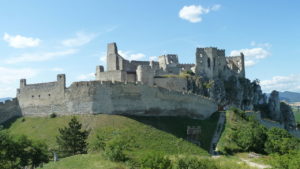Beckó, Bolondóc

Beckó (Beckov, Beckow) castle is a gem of Hungarian medieval history and a precious stone of Slovakia in our days as it is located in the historical Upper lands/Horná Zem/Felvidék. Both nations can be equally proud of it. The castle is on the left bank of the River Vág. It is also called Bolondóc or Stribor castle and it was there in the 12th-century already. There are several legends of this castle about the cruel Lord Stibor and his death.

Beckó is said to have been a headquarters of the local Comes of the Hungarian king, it was first mentioned in the Chronicle of Anonymus after 1205. As the fort stands on a 245-high rock, the garrison was able to defend it successfully against the Mongols in 1241. Similarly to other fortifications of the northern lands of medieval Hungary, Beckó was also taken by the powerful oligarch called Csák Máté at the beginning of the 14th century. These castles and lands were returned to the king, Károly Róbert only in 1321.
It was owned by the famous and perhaps infamous Polish knight, Lord Stibor in the 14th century who was a great supporter of King Zsigmond of Hungary. These were the heydays of Beckó when Lord Stibor controlled his lands from there. He turned the place into a splendid palace in those days. The last heir of the Stibor family was Stiborici Katalin after 1434 and she got married to Bánffy Pál of Alsólindva. Thus, the castle became the property of the Bánffy family until the 20th century.

In the Turkish age, it was surrounded by an outer wall, though the battles of the Ottoman wars were far away from this quite safe place. The chronicles recorded merely one occasion when a Crimean Tatar raiding party appeared at the walls of Beckó in 1599 but the garrison could easily scatter them. There were 218 houses in the small town in 1598. Strategically, the castle was not very important so only one such bastion was built that was able to answer the challenge of the quickly developing artillery.
The settlement below the castle had a right to keep markets as early as 1520. Its Franciscan monastery was built in 1689. During the 17th century, the small town had some guilds: boot-makers, broad-cloth makers, and millers lived there. The Mednyánszky family had a manor and palace there in 1540. Its church is built in the Gothic and Renaissance style. It is assumed, that the garrison always opened the castle’s gates willingly to the Transylvanian princes (Bocskai István, Bethlen Gábor, Rákóczi György I.- *Please note, that I use the Eastern name order for Hungarian names) when they were attacking the Habsburgs during the 17th century.
The male line of the Bánffy family ceased to exist in 1644 and the female members of the family were debating for decades about the ownership of the castle and the 17 villages belonging to it. Sadly, nobody paid attention to the condition of the castle during these years. The last military action took place at Beckó in 1707. The “kuruc” rebels of Captain Ocskay László attacked and took the small town that was surrounded only by a low stone wall. When they assaulted the castle, the defenders repelled them by savage rifle fire. As revenge, the rebels pillaged the town along with the churches.
Moreover, they herded the town’s naked women to the snowy streets, according to contemporary records. When Prince Rákóczi Ferenc II’s army was defeated at Trencsén castle in 1708, the rebels had to leave the area. We assume, that Beckó castle was not exploded in 1711 by the Habsburgs like so many forts in Hungary because its owners were loyal to the king.

There was a huge fire in 1729 when the entire castle burned down. Due to the huge expenses, the owners didn’t rebuild it. Instead, they moved to their more comfortable palaces and stately homes in the surrounding villages. Archeological work began in 1970 and there were closed areas in 2002 where tourists were not allowed to enter. We can just guess how one of the most impressive Gothic palaces of the Kingdom of Hungary may have looked like in the 15th century. Here is my article about the reasons why we cannot find so many traces of Gothic and Renaissance buildings in Hungary:
https://www.hungarianottomanwars.com/essays/why-is-the-hungarian-renaissance-not-so-well-known/

Dear Readers, I can only make this content available through small donations or by selling my books or T-shirts.
If you like my writings, please feel free to support me with a coffee here:
You can check out my books "33 Castles, Battles, Legends" and "The Ring of Kékkő Castle" on Amazon or Draft2Digital, they are available in hardcover, paperback, or ebook: https://www.amazon.com/dp/198020490X or at https://books2read.com/b/boYd81
 My work can also be followed and supported on Patreon: Become a Patron!http://Become a Patron!
My work can also be followed and supported on Patreon: Become a Patron!http://Become a Patron!





























